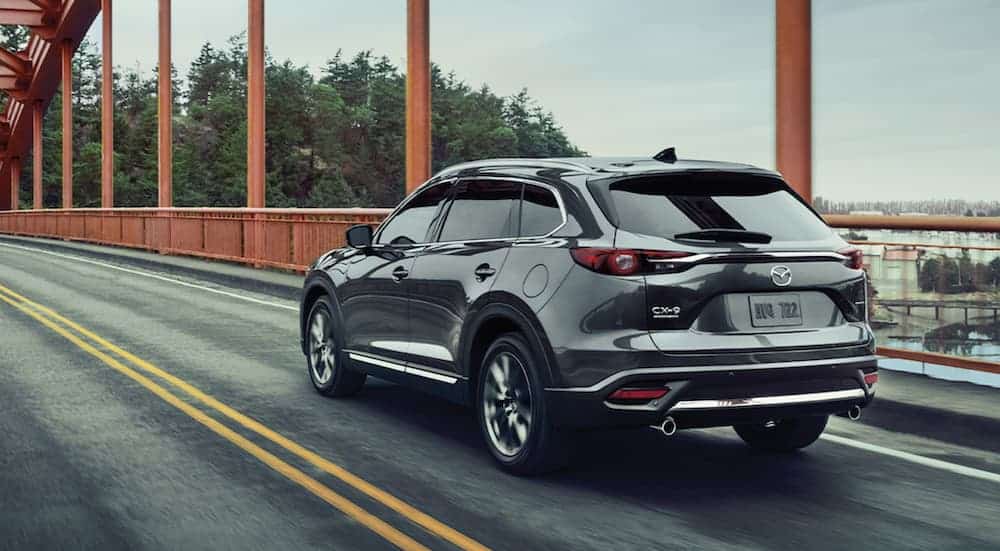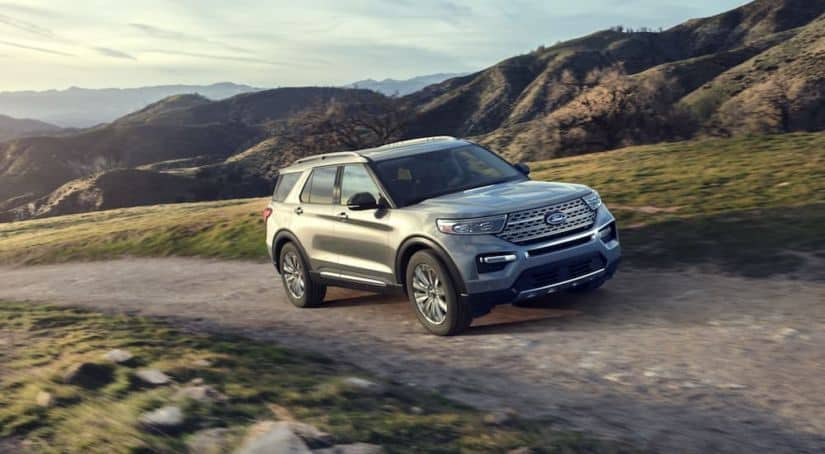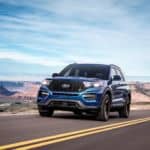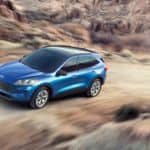If you’re ready to sink your teeth into a three-row SUV that actually owns up to its price, you might be paring down to a shortlist. We’re going to compare the features and powertrain of the 2020 Ford Explorer vs 2020 Mazda CX-9 to give you the low-down on which one of these three-row SUVs will give you the best bang for your buck.
Since most buyers tend to go for the trim level one above the base to gain the most standard features for the price, we will compare between the 2020 Explorer XLT and the 2020 Mazda Touring models. The pricing for the Explorer XLT kicks off at an MSRP of $36,675, compared with the Mazda Touring at $35,710. Already the brand known for its speedy zip is getting ahead, but will the Mazda hold the lead? Only one way to find out.
Powertrain and Performance
Let’s start under the hood and chassis, shall we? The Explorer XLT comes standard with rear-wheel drive, which may seem like a backward step until you understand the better performance for towing capability. Ford has truck power built into its DNA, so it’s no surprise the Explorer is making the most of its size to offer a more capable towing platform. The standard engine is a 2.3-liter turbocharged, direct-injection Ti-VCT EcoBoost I-4. What the heck is that? It’s a fancy way of saying it’s an inline 4-cylinder, and it sings to the tune of 300 hp with 310 lb-ft of torque. Also noteworthy is the 10-speed automatic transmission. This beast can tow up to 5,300 pounds. Fuel economy is 21 MPG in the city and 28 MPG on the highway.
Under the hood of the Mazda Touring, this model comes standard with the Skyactiv-G 2.5T Dynamic Pressure Turbo DOHC, 16-valve 4-cylinder with VVT engine. Again, what does that mean? It has a 2.5-liter 4-cylinder engine that will get 227 hp and 310 lb-ft of torque on regular unleaded gas. With high octane gasoline, you can up the horsepower to 250 and 320 lb-ft of torque. The Touring comes standard with front-wheel drive and off-road traction assist and has an automatic 6-speed transmission with sport mode. Towing capacity comes in at 3,500 pounds. Fuel economy is 22 MPG in the city and 28 MPG on the highway. In the comparison of engines, Ford is the clear winner with a near 2,000 pounds of brute force for towing tossed into its corner, along with the 10-speed automatic transmission.

Exterior
On the outside, the styling is mildly different, with the Ford coming across as more boxy and aggressive, while the Mazda is more streamlined with a prominent front grille. Ford offers standard features like LED headlights and signal lights; side mirrors which are powered, heated, fold manually, and have security approach lamps and black caps. There is also a power liftgate, roof rails, privacy glass in the second and third rows, 18-inch aluminum wheels, and a dual exhaust with chrome tips. It will have a wheelbase of 119.1 inches, a length of 198.8 inches, and a height of 69.9 inches.
Mazda has similar features, with LED headlights and signals, side mirrors that are powered, heated, and include integrated LED turn signals, rear privacy glass and dual exhaust outlets. It will also have a rear roof spoiler, intermittent rain-sensing windshield wipers, and 18-inch aluminum wheels. The Mazda CX-9 will have a wheelbase of 115.3 inches, a length of 199.4 inches, and a height of 69 inches. On this level of the playing field, the two vehicles are just about neck-and-neck, with the main differences being whether you prefer having the slightly fancier side mirrors of the Ford or the rain-sensing windshield wipers of the Mazda.
Interior
Beginning with seating and trim, Ford offers seating for seven in the XLT. Seats are cloth, but you get an 8-way powered driver’s seat, second-row captain seats with power-assist folding, a third row 50/50 split-bench seat that folds manually, and it will have a pass-through second-row console. The Mazda Touring also offers seating for seven. Seats are leather-trimmed in the first and second rows, and you get a powered driver’s seat with lumbar support, powered passenger seat, heated front seats, 60/40 split second-row seats which fold down and recline, tilt-and-slide third-row access, 50/50 split third row, and a leather-wrapped steering wheel and shift knob. Here, the main difference is the leather and nicer additions of the front row of the Mazda, compared with the second-row captain chairs of the Ford. This may boil down to preferences, but heated seats are really nice on cold mornings.
When it comes to comfort, convenience, and safety, the Ford XLT comes standard with key features. These include lane-keeping assist, lane-keeping alert, driver alert, a rear-view camera with washer, roll stability control, post-crash alert system, and reverse sensing for safety. Also standard is an integrated keypad entry located on the driver door, remote start, integrated key fob, intelligent access with push-button start, and MyKey, which can be programmed to limit certain features like top speed or stereo volume. Tri-zone filtered temperature control with rear auxiliary control allows for all three rows of seats to choose their comfort. A unique capless fuel filler and three total 12-volt power outlets (front, second row, and cargo area) cover the most interesting features.
Mazda’s Touring comes standard with safety features like an engine immobilizer to prevent theft, lane-keeping, lane departure assist, pedestrian detection, blind-spot monitoring, rear cross-traffic alert, hill launch assist, roll stability control, and a rear-view camera. Further features are advanced keyless entry and start system with push-button start, radar cruise control with stop and go capabilities, auto-dimming rear-view mirror with Homelink, front door courtesy lights, and front door pocket lights. Tri-zone climate control with pollen filtration is a feature in common with Ford. A powered liftgate, remote fuel door release, and two 12-volt power outlets (front and cargo areas) complete the list. Again, we’re fairly close on features here, with much of the list being preference-based.

Both vehicles offer trailering assistance, with Ford offering its signature Co-pilot 360, which offers blind-spot monitoring that includes trailer tow coverage if you equip it. Otherwise, an optional trailering package can be added. Mazda comes standard with trailer stability assist, which is paired with the traction and stability control. Both vehicles look fair on paper, but Ford really has one up on the trailering. This is a vehicle made to tow, and Ford has the proper tools to make that as simple as possible on the road.
When it comes to infotainment, Mazda Touring comes standard with 9” color touch screen, HD radio, Bluetooth hands-free phone and audio, Apple CarPlay and Android Audio, an auxiliary audio input jack, USB input (2 front and rear), and steering wheel-mounted controls. Mazda’s signature infotainment system incorporates voice-command operation, audio text reply, internet-connected streaming, and auto emergency 911 notification.
Ford’s infotainment system comes loaded with the FordPass Connect which adds a 4G hotspot, it’ll have dual second-row USB charging ports, Sirius XM radio, and a six-speaker system compatible with MP3. The option to upgrade to voice-activated navigation is there, though admittedly, this system looks paltry in comparison with the Mazda’s evident tech-heavy Touring trim.
The Wrap-Up
This comparison is a fairly even match in a war of features. What tips the scale are specific features buyers may want, depending on the purpose the vehicle will serve. If you plan to tow a trailer, the Ford is the obvious choice. If technology is important to you, Mazda may be the better option. If heated seats and lumbar support matter to you, Mazda won’t make you pay extra for it, but Ford has the better engine with more power. When it comes to what’s under the hood and chassis, Ford definitely wins the battle. Which one would you buy? It’s the buyer’s choice.



